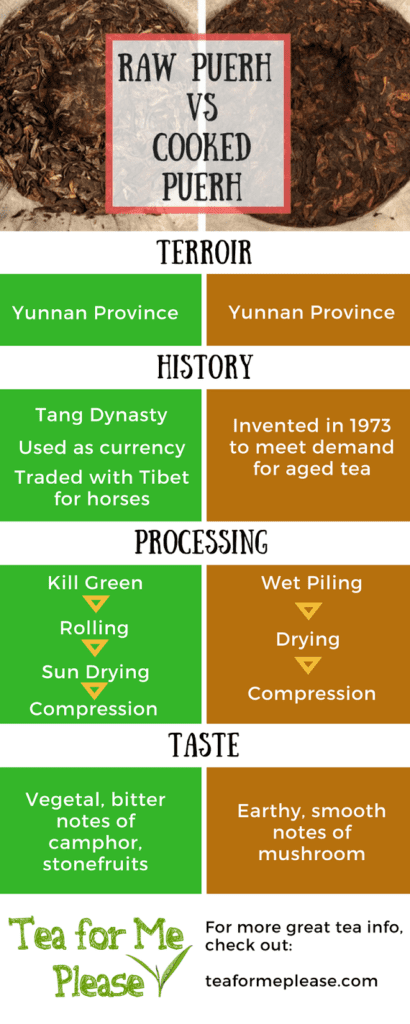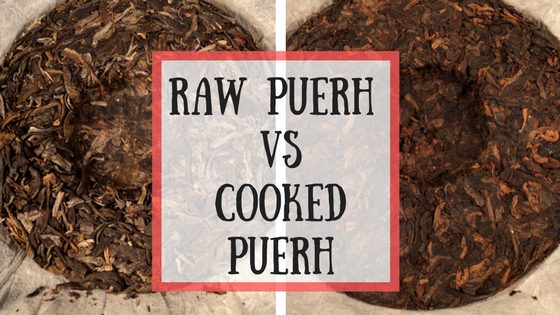When I first got into tea, I thought I hated puerh. A lot of that had to do with the first samples I tried being terrible examples. My revelation came when I discovered sheng, aka raw puerh. My taste buds did a happy dance. There was stuff that didn’t taste like fish and dirt! That was many years ago and I’ve come to enjoy shou as well. I wish someone had explained all of these nuances to me way back when so I thought it might be fun to put a post together that compares the two.
Terroir
All puerh, whether it is raw or cooked, must be grown in southwestern China’s Yunnan Province. This creates a bit of a gray area because man-made borders are not permanent things. Neighboring countries like Laos produce very similar tea but technically their teas cannot be called puerh. I’ve seen fermented teas from a variety of places, even some as far-flung as Malawi, labeled as puerh. Hei cha, also known as dark tea, is a more appropriate term. All puerh is hei cha but not all hei cha is puerh.
Yunnan is a fascinating region and the one that I probably enjoy learning about the most. It is the most biologically diverse part of China. Many believe it to be the birthplace of the tea plant, Camellia Sinensis. Each of the mountain areas that produce tea have a distinctive style and taste. Some of the trendier and higher demand regions are all but impossible for the average tea drinker to obtain. Yunnan is also home to twenty-five recognized minority ethnic groups. Each of these groups has their own histories and culture, many of which revolve around tea.
History
Processing
Taste
I often describe sheng to people who’ve never had it as a green tea that punches you in the face. That sounds a bit extreme but the astringency that puerh packs can be alarming to the uninitiated. Since the leaf is green vegetal tastes are usually at the forefront but a wide range of flavor notes can also occur. I’ve tasted everything from camphor and smoke to flowers and stone fruits. Raw puerh is famous for having hui gan, a comeback sweetness in the throat. The younger the tea is, the more likely it will be to have some bite. Lower water temperatures and shorter steep times can help dial down this aspect.
Shou puerh, on the other hand, has an earthy and woodsy taste. Mushroom is the tasting note that I hear most often but I’ve had teas that taste like cacao and brown sugar too. One of the things I enjoy the most about this type of tea is that they usually have a soothing natural sweetness. Cooked puerh brews up extremely dark and it’s often even darker on the second infusion. Beware of poor quality tea (aka anything you’ll find on the shelf of the local Asian grocery). They will most assuredly taste like a mushroom infested swamp.
Are you more of a sheng or shou person? Let me know in the comments!


Nice Nicole,
To a novice who is just beginning to explore beyond what is placed in front of you at the local Chinese restaurant and Grandmother’s Swee-Touch-Nee, your articles are very helpful and informative.
Thank you so much! Tea is a rabbit hole that just keeps going and going in the best way.
I drink some pretty cheap Pu erh that I buy on Amazon (Jinglong – $10 for 25 little mushroom heads). I like it; it tastes and looks dark, slightly earthy , just a hint of fishiness and mushroominess, and mellow, not bitter at all. It’s elevating, but also quite relaxing. Maybe someday I’ll get some of the high end stuff, but right now this works for me.
I like the ripe Pu erh better! And I use a French Press to brew all my teas. I usually have 3 pots going, a wulong, a mixed black tea, and a pu erh. I keep adding and rebrewing until the pot is full and then rebrew until the goodness has disappeared. I live in Tucson, the home of one of the best online tea sellers, Seven Cups and what an awesome company they are.
You’re very lucky! Seven Cups has been one of my favorite tea companies for many years.